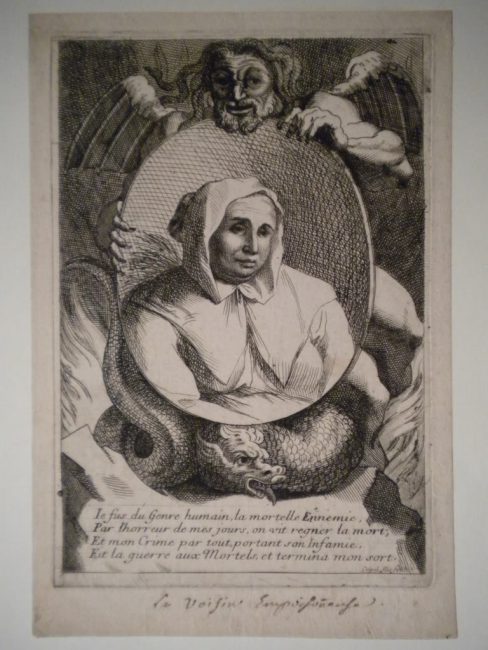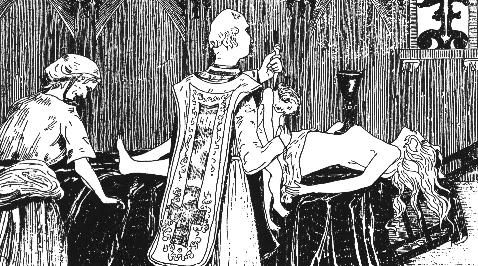
Catherine Deshayes, “La Voisin” (c. 1640 – February 22, 1680)
On February 22, 1680, Catherine Deshayes Monvoisin, aka La Voisin, was sentenced to death for witchcraft and poisoning, and burned at the stake. This Affair of the Poisons (L’affaire des poisons) was a major murder scandal in France which took place in 1677–1682, during the reign of King Louis XIV. During it, a number of prominent members of the aristocracy were implicated and sentenced on charges of poisoning and witchcraft. The scandal reached into the inner circle of the king. It led to the execution of 36 people.
The Trial of Madame de Brinvilliers
Sounds scary? It should! The origin of the case began in 1675 after the trial of Madame de Brinvilliers,[5] who had conspired with her lover, army captain Godin de Sainte-Croix, to poison her father Antonine Dreux d’Aubray in 1666 and two of her brothers, Antoine d’Aubray and François d’Aubray, in 1670, in order to inherit their estates. There were also rumors that she had poisoned poor people during her visits in hospitals. She fled, but was arrested in Liège. She was forced to confess, sentenced to death and on 17 July was tortured with the water cure (forced to drink sixteen pints of water), beheaded and burned at the stake. Her accomplice Sainte-Croix had died of natural causes in 1672. The sensational trial drew attention to a number of other mysterious deaths, starting a number of rumours. Prominent people, including Louis XIV, became alarmed that they also might be poisoned.

Catherine Monvoisin and the priest Étienne Guibourg perform “Black Masses” for the mistress of King Louis XIV of France, Madame de Montespan (lying on the altar).
Inheritance Powders
The affair proper opened in February 1677 after the arrest of Magdelaine de La Grange on charges of forgery and murder. La Grange appealed to François Michel le Tellier, Marquis of Louvois, claiming that she had information about other crimes of high importance. The subsequent investigation of potential poisoners was led to accusations of witchcraft, murder and more. Authorities rounded up a number of fortune tellers and alchemists who were suspected of selling not only divinations, séances and aphrodisiacs, but also “inheritance powders” (a euphemism for poison). Some of them confessed under torture and gave authorities lists of their clients, who had allegedly bought poison to get rid of their spouses or rivals in the royal court.
The Midwife Catherine Deshayes Monvoisin
The most famous case was that of midwife Catherine Deshayes Monvoisin or La Voisin, who was arrested in 1679 after she was incriminated by the poisoner Marie Bosse. La Voisin implicated a number of important individuals in the French court. These included Olympia Mancini, the Comtesse de Soissons, her sister Marie Anne Mancini Duchesse de Bouillon, François Henri de Montmorency, Duke of Luxembourg and, most importantly, the king’s mistress, Athénaïs de Montespan. Questioned while intoxicated, La Voisin claimed that de Montespan had bought aphrodisiacs and performed black masses with her in order to gain and keep the king’s favor over rival lovers. According to rumors remains of 2,500 infants were found buried in La Voisin’s garden, but the truth of this accusation is still disputed.
Chiromancy and Face Reading
Catherine Deshayes was married to Antoine Monvoisin, a jeweller with a shop at Pont-Marie in Paris. After her husband was ruined, La Voisin started her career by practizing chiromancy and face-reading to support her family. She practiced medicine, especially midwifery, and performed abortions. She arranged black masses, where the clients could pray to the Devil to make their wishes come true. During at least some of these masses, a woman performed as an altar, upon which a bowl was placed: a baby was held above the bowl, and the blood from it was poured into the bowl. La Voisin was convicted of witchcraft and was burned in public on the Place de Grève in Paris the 22 February 1680.
Aftermath
In July, her daughter Marguerite Monvoisin revealed her connection to Montespan, which was confirmed by the statements of the other accused. This caused the monarch to eventually close the investigation, seal the testimonies and place the remaining accused outside of the public justice system by imprisoning them under a lettre de cachet. The Poison Affair implicated 442 suspects: 367 orders of arrests were issued, of which 218 were carried out. Of the condemned, 36 were executed; five were sentenced to the galleys; and 23 to exile
Teofilo Ruiz, The Terror of History: The Witch Hunt in Early Modern Europe, UCLA, [7]
References and Further Reading:
- [1] Excerpts from Bastille trial records of Guibourg and LaVoisin
- [2] La Voisin in the Encyclopedia Britannica
- [3] La Voisin at Wikidata
- [4] Frances Mossiker – The Affair of the Poisons: Louis XIV, Madame de Montespan, and one of History’s great Unsolved Mysteries (Alfred A. Knopf (1969)
- [5] The Marquise de Brinvillier and the Affair of the Poisons, SciHi Blog
- [6] H Noel Williams: Madame de Montespan and Louis XIV
- [7] Teofilo Ruiz, The Terror of History: The Witch Hunt in Early Modern Europe, UCLA, 2007, UCLA @ youtube
- [8] Serial Killers and the date of their execution, via Wikidata





